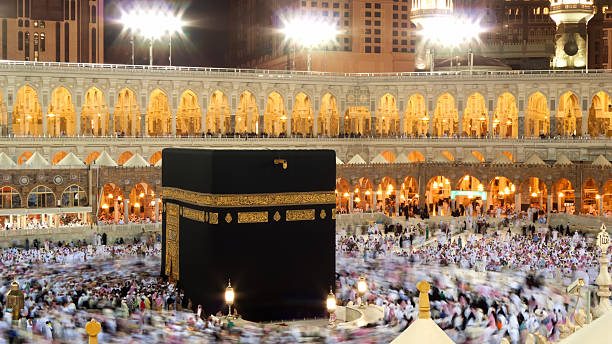In the heart of the holy city of Mecca.
stands a structure that holds profound spiritual significance for millions of Muslims around the world. The Kaaba, or "House of God," is a symbol of unity, devotion, and reverence, drawing pilgrims from every corner of the globe to perform the sacred rites of Hajj and Umrah. With its rich history, architectural grandeur, and spiritual allure, the Kaaba stands as a timeless beacon of faith and piety.
### **Historical Background:**
The history of the Kaaba dates back to the time of Prophet Ibrahim (Abraham), who, according to Islamic tradition, was commanded by Allah to construct the sacred sanctuary as a place of worship. Over the centuries, the Kaaba underwent various reconstructions and renovations, with each successive generation adding to its splendor and sanctity.
The Kaaba holds a central place in Islamic theology and history, serving as the focal point for Muslim prayers and the direction towards which all Muslims pray, regardless of their geographical location. Its significance is deeply rooted in the beliefs and practices of Islam, symbolizing the unity of the Muslim community and the spiritual center of the Islamic faith.
### **Architectural Marvels:**
The Kaaba is a simple yet striking structure, standing approximately 15 meters high and draped in a black silk cloth known as the Kiswa. Its cubic shape is adorned with intricate calligraphy and geometric patterns, reflecting the rich artistic traditions of Islamic architecture. The structure is made of granite from the nearby hills of Mecca, giving it a solid and enduring presence.
One of the most distinctive features of the Kaaba is the Black Stone (Hajar al-Aswad) embedded in its eastern corner. According to Islamic tradition, the Black Stone was given to Prophet Ibrahim by the angel Gabriel and holds great spiritual significance for Muslims. Pilgrims circle the Kaaba during Hajj and Umrah, kissing or touching the Black Stone as a symbol of their devotion and humility.
### **Spiritual Significance:**
For Muslims, the Kaaba represents the earthly dwelling place of Allah and the ultimate destination of their spiritual journey. It is a symbol of unity and equality, as all pilgrims, regardless of their status or nationality, stand shoulder to shoulder in prayer, united in their devotion to the one true God.
The annual pilgrimage of Hajj, during which millions of Muslims converge on Mecca to perform a series of rituals centered around the Kaaba, is considered one of the five pillars of Islam. Hajj is a deeply transformative experience, bringing together people from diverse backgrounds and cultures in a profound expression of faith and solidarity.
Umrah, a lesser pilgrimage that can be performed at any time of the year, also involves circling the Kaaba and performing other rituals that symbolize spiritual purification and renewal. Both Hajj and Umrah hold immense spiritual significance for Muslims, providing an opportunity for repentance, reflection, and renewal of faith.
### **Cultural Significance:**
Beyond its religious significance, the Kaaba holds a special place in the hearts and minds of Muslims as a symbol of their cultural identity and heritage. It is a source of inspiration for artists, poets, and scholars, who have celebrated its beauty and significance in various forms of creative expression.
The annual changing of the Kiswa, during which the black cloth covering the Kaaba is replaced with a new one, is a tradition that dates back centuries and is steeped in symbolism and ritual. The Kiswa is made of fine silk and embroidered with verses from the Quran, serving as a visual representation of the sanctity and reverence associated with the Kaaba.
### **Preservation and Maintenance:**
The preservation and maintenance of the Kaaba are of utmost importance to the custodians of the holy sanctuary, who are entrusted with its care and upkeep. Specialized teams are responsible for ensuring the structural integrity of the Kaaba, as well as the maintenance of its surrounding infrastructure, including the Masjid al-Haram (the Grand Mosque) and the surrounding streets and plazas.
Efforts are also made to accommodate the growing number of pilgrims who visit the Kaaba each year, with improvements made to transportation, accommodation, and crowd management systems. Despite the challenges posed by the ever-increasing number of visitors, the custodians of the Kaaba are committed to ensuring that the sanctity and spiritual significance of the holy sanctuary are preserved for future generations.
### **Conclusion:**
The Kaaba stands as a symbol of faith, unity, and devotion for Muslims around the world, drawing millions of pilgrims to its sacred precincts each year. With its rich history, architectural splendor, and spiritual significance, the Kaaba serves as a timeless reminder of the enduring power of faith and the universal values of peace, compassion, and humility. As the spiritual center of Islam, the Kaaba continues to inspire awe and reverence, serving as a beacon of hope and guidance for all who seek solace and salvation in its sacred embrace.



You must be logged in to post a comment.